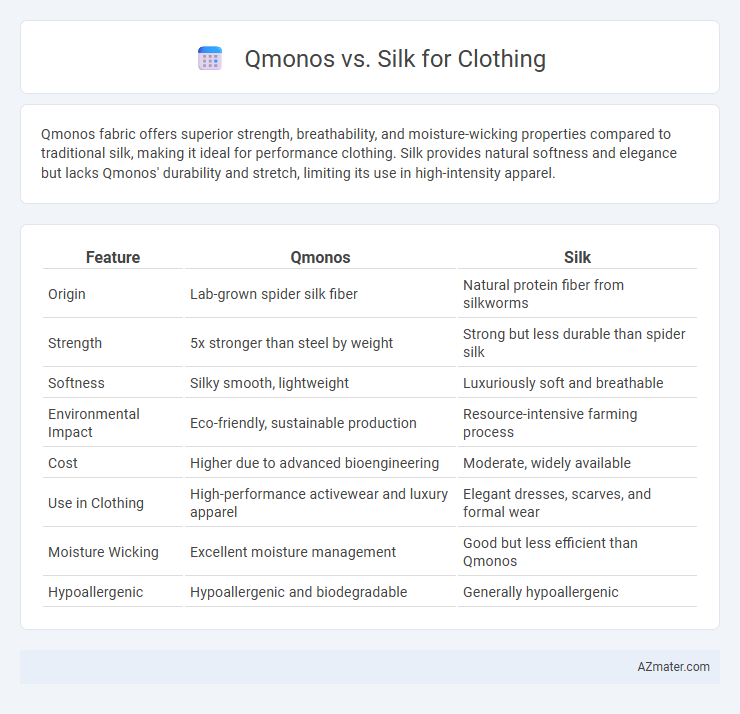Qmonos fabric offers superior strength, breathability, and moisture-wicking properties compared to traditional silk, making it ideal for performance clothing. Silk provides natural softness and elegance but lacks Qmonos' durability and stretch, limiting its use in high-intensity apparel.
Table of Comparison
| Feature | Qmonos | Silk |
|---|---|---|
| Origin | Lab-grown spider silk fiber | Natural protein fiber from silkworms |
| Strength | 5x stronger than steel by weight | Strong but less durable than spider silk |
| Softness | Silky smooth, lightweight | Luxuriously soft and breathable |
| Environmental Impact | Eco-friendly, sustainable production | Resource-intensive farming process |
| Cost | Higher due to advanced bioengineering | Moderate, widely available |
| Use in Clothing | High-performance activewear and luxury apparel | Elegant dresses, scarves, and formal wear |
| Moisture Wicking | Excellent moisture management | Good but less efficient than Qmonos |
| Hypoallergenic | Hypoallergenic and biodegradable | Generally hypoallergenic |
Introduction to Qmonos and Silk
Qmonos is a next-generation synthetic fiber known for its lightweight, durable, and highly elastic properties, making it ideal for activewear and performance clothing. Silk, a natural protein fiber produced by silkworms, offers exceptional softness, breathability, and a luxurious sheen, commonly favored in high-end fashion and formalwear. While Qmonos emphasizes innovative strength and stretch, silk stands out for its natural elegance and comfort in apparel.
Origins and Production Processes
Qmonos, a bioengineered spider silk protein developed through genetic engineering of yeast, offers a sustainable alternative to traditional silk by replicating the molecular structure of natural spider silk. Silk, derived from the silkworm Bombyx mori, involves an extensive sericulture process including cultivation, harvesting, and spinning of silk fibers. Qmonos production emphasizes fermentation technology for scalable fiber synthesis, contrasting with silk's reliance on sericulture and manual extraction methods.
Material Composition and Structure
Qmonos fabric, a bioengineered spider silk, consists of protein fibers that replicate the natural silk's strength and elasticity, offering superior durability and moisture-wicking properties compared to traditional silk. Traditional silk, composed primarily of fibroin proteins produced by silkworms, features a smooth and lustrous texture but lacks the enhanced tensile strength and flexibility of Qmonos. The structural difference lies in Qmonos's recombinant spider silk proteins arranged to mimic spider silk's microfibril organization, resulting in a textile with higher tensile strength and greater resilience than conventional silkworm silk fibers.
Eco-Friendliness and Sustainability
Qmonos fibers, derived from genetically engineered spider silk proteins, offer superior biodegradability compared to traditional silk, reducing environmental pollution. Silk production involves intensive water use and chemical treatments, whereas Qmonos uses biofabrication techniques that minimize carbon footprint and resource consumption. The sustainable manufacturing process of Qmonos supports circular economy goals by enabling biodegradable textiles with lower ecological impact.
Comfort and Wearability Comparison
Qmonos fiber offers exceptional strength and durability while maintaining a lightweight, breathable structure, enhancing comfort for extended wear in clothing. Silk provides a soft, natural sheen and excellent moisture-wicking properties, promoting skin comfort and temperature regulation. Compared to silk, Qmonos excels in wearability for active or demanding environments due to its superior tensile strength and resistance to wear and tear.
Durability and Strength
Qmonos fabric outperforms Silk in durability and strength, making it ideal for high-performance clothing and martial arts uniforms. Its synthetic fibers offer exceptional resistance to tearing and abrasion, sustaining repeated stress without compromising fabric integrity. In contrast, Silk's natural fibers, while luxurious and soft, wear down faster under heavy use and are more prone to damage.
Aesthetic Qualities and Appearance
Qmonos fabric offers a sleek, lightweight texture with a subtle sheen that enhances the drape and silhouette of clothing, making it ideal for form-fitting garments and evening wear. Silk, renowned for its natural luster and smooth finish, provides a rich, vibrant appearance that elevates both casual and formal attire with its fluid movement and luxurious feel. While Qmonos maintains shape retention and resistance to wrinkles, silk delivers unmatched elegance through its soft glow and timeless aesthetic appeal.
Care and Maintenance Requirements
Qmonos fiber offers high durability with easy-care properties, requiring low heat for washing and drying while maintaining strength and shape retention. Silk, known for its luxurious feel, demands gentle hand washing or dry cleaning with mild detergents to prevent damage to its delicate protein fibers. Proper storage and minimal exposure to sunlight are essential for both fabrics to preserve color vibrancy and fabric integrity over time.
Cost and Market Availability
Qmonos fibers offer competitive cost advantages due to scalable production methods compared to traditional silk, which remains expensive and labor-intensive. While silk dominates the luxury clothing market with well-established supply chains, Qmonos is gaining traction for sustainable and high-performance apparel but has limited widespread market availability. Manufacturers prioritize Qmonos for innovative activewear, whereas silk retains preference in premium fashion sectors.
Future Prospects in Fashion Industry
Qmonos, a bioengineered spider silk, presents a sustainable alternative to traditional textiles like Silk by offering superior strength, elasticity, and biodegradability, crucial for the future fashion industry's shift towards eco-friendly materials. The scalability of Qmonos production through microbial fermentation promises to reduce environmental impact and dependency on animal-based silk harvesting, aligning with increasing consumer demand for ethical fashion. Innovations in Qmonos integration with smart textiles and wearable technology position it as a transformative material driving the next generation of high-performance, sustainable clothing.

Infographic: Qmonos vs Silk for Clothing
 azmater.com
azmater.com